Penygroes is a village located in the heart of the coal mining area of Carmarthenshire, on the B4556 road between Gorslas and Llandebie, just under two miles from Cross Hands. There are two war memorials inside Penygroes Welfare Hall which commemorate the men from the village who fell during both World Wars, and take the form of engraved brass plaques. The photographs of the memorials have been kindly supplied by Adrian Davies and David Thomas.
The Great War, 1914-1918
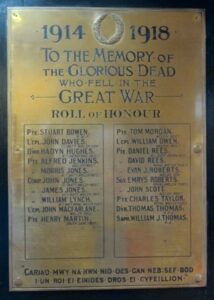
Stuart Rendal Bowen, Private, 14168, Royal Welsh Fusiliers. Stewart was the son of John and Miriam Bowen, of 4, Brisken Villa, Llandeilo. By 1911 the family had moved to 31, Maesquarre Road, Ammanford. Stewart had enlisted at Llandeilo into the Royal Welsh Fusiliers. He had served in France from 5 September 1915 with one of the regular battalions of the Royal Welsh Fusiliers before being invalided home. He sadly died at Liverpool Military Hospital on 14 February 1917, aged 24. Stewart is buried in Llandeilo (Bethel) Calvinistic Methodist Chapelyard. Many thanks to W. Stuart Davies for the photograph.
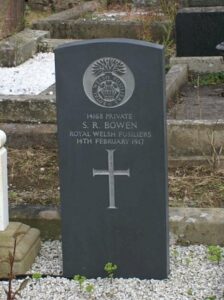
John Davies, Lance Corporal, 1628, Welsh Guards. John was born at Caio, and was the adopted son of Thomas and Elizabeth Davies, of 4, Cefn Tir Esgob, Llandilo. He worked as a Grocer’s Assistant at Penygroes prior to the war and enlisted at Ammanford into the 1st Battalion, Welsh Guards, which had been formed early in 1915 and attached to 3 Guards Brigade, Guards Division. This Division has the distinction of being formed in France in August 1915. The various Guards units that had been with other Divisions were withdrawn to be brought together to create this fine formation. It remained on the Western Front throughout the war and saw its first major action during the Battle of Loos on 25 September 1915, remaining in the area during the coming months, where they also fought in the subsequent Action of Hohenzollern Redoubt. The guards then had a spell at Ypres, holding the Canal Bank sector until the end of July 1916. John was killed here on 17 July 1916, aged 20. He is buried near Ypres, at Brandhoek Military Cemetery, Belgium.
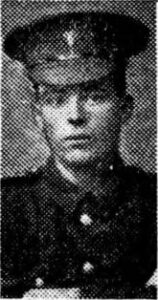
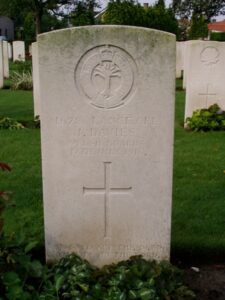
John Evans, Stoker 1st Class, SS/113344, Royal Navy. John was born on 18 July 1894, the son of Edward Thomas and Amelia Evans, of 7, Garden Square, North Street, Exeter. He worked as a Collier at Penygroes prior to the war, before enlisting into the Royal Navy. John was posted aboard the Battlecruiser H.M.S. Indefatigable, where he became a Stoker. Indefatigable was attached to the 2nd Battlecruiser Squadron, and was based at Rosyth. When news of the German High Seas Fleet being put to sea reached the Admiralty, the various battle fleets were put to sea to intercept the Germans. Indefatigable left her moorings at Edinburgh on 30 May 1916 and steamed towards the German fleet, which was approaching the North Sea. When the two mighty fleets met at Jutland on 31 May 1916, Indefatigable began laying fire down on the Germans, but was struck by a salvo of shells from SMS Van Der Tann, which exploded her magazines, and Indefatigable blew apart, with the loss of 1,017 men. John was 21 years old when he died on 31 May 1916, and is commemorated on the Plymouth Naval Memorial, Devon. Evan is not commemorated locally.
Charles Haydn Lloyd Hughes, Private, 14180, Northamptonshire Regiment. Charles, known as Haydn, was born in 1897, the son of Thomas and Sarah Hughes, of Mount Pleasant, Llandebie. He later lived at Caerbrynfach, Penygroes, and enlisted into the Northamptonshire Regiment. Haydn doesn’t seem to have served overseas, and died while training in Denbighshire on 5 October 1915, aged 19. He is buried in Penygroes (Jerusalem) Calvinist Methodist Chapelyard.
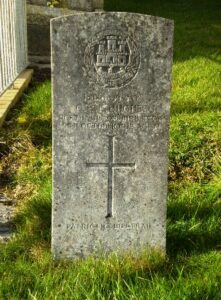
William John Hughes, Private, 26467, Welsh Regiment. William was the son of John and Hannah Hughes, Gorsfach, Gorslas. He resided at 4, Lewis Terrace, Penygroes prior to the war, and enlisted at Porth into the 17th Battalion, Welsh Regiment. The Battalion was attached to 119 Brigade, 40th (Bantam) Division, which was formed between September and December 1915, composed of bantam units and others which had a mixture of regulation-height and shorter men. Weeding out of very under-sized or unfit men delayed the training programme, and it was not until late spring 1916 that the Division was ready to proceed on active service. The Division moved to France between 1 and 9 June, and moved to the front near Loos. Late in 1916 they moved south to the Somme, and fought at the Battle of the Ancre, and remained in the area over the winter. In March, 1917 the Germans withdrew to their shortened line, called the Hindenburg Line, and the 40th Division were one of the Divisions that followed the withdrawal. William was killed in action during this period, on 24 April 1917, aged 18. He is buried at Fifteen Ravine British Cemetery, Villers-Plouich, France. William is not named on the war memorial.
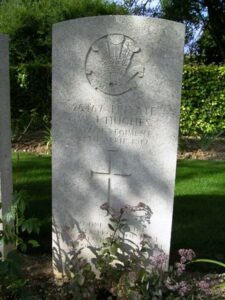
Alfred Jenkins, Private, 4629, Welsh Regiment. Alfred was the son of John and Maria Jenkins, of Llwynyrynn, Penygroes. He enlisted at Llanelli into the 1/6th Battalion, Welsh Regiment, which was the Glamorgan Territorial battalion. The battalion moved to France on 29 October 1914, and moved to work on Lines of Communication. On 5 July 1915 the battalion became attached to 84 Brigade, 28th Division, then on 23 October 1915 transferred to 3 Brigade, 1st Division, becoming Divisional Pioneers. After the Armistice, the Battalion became part of the Army of Occupation in Germany. Alfred died in Germany on 16 August 1919, aged 33. He is buried in Cologne Southern Cemetery, Germany.
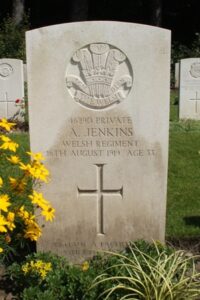
James Jones, Private, 20026, Welsh Regiment. James was the son of Daniel and Mary Jane Jones, of 4, Towy Avenue, Llandovery. He enlisted at Ammanford along with his brother John, into the 15th Battalion, the Welsh Regiment, which was the Carmarthen Pals battalion, attached to 114 Brigade, 38th (Welsh) Division. The Division landed in France in December 1915 and moved to the Armentieres area where they were initiated into trench warfare. They then moved to the Somme in June, 1916, to take part in the attack on Mametz Wood, which began on 7 July 1916. The attack failed, and so 114 Brigade went in again on 10 July and were decimated. James was killed in action during the assault across ‘Death Valley’, on 10 July 1916, alongside his brother John. He was 21 years old and is remembered on the Thiepval Memorial, France.
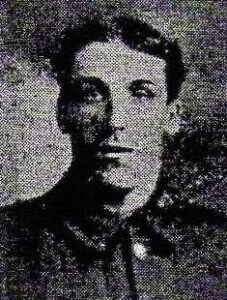
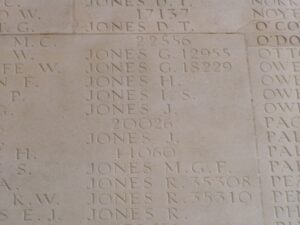
John Jones, Corporal, 20027, Welsh Regiment. John was the son of Daniel and Mary Jane Jones, of 4, Towy Avenue, Llandovery. He enlisted at Ammanford along with his brother James, into the 15th Battalion, the Welsh Regiment, known as the Carmarthen Pals battalion, which was attached to 114 Brigade, 38th (Welsh) Division. The Division landed in France in December, 1915 and moved to the Armentieres area where they were initiated into trench warfare. They then moved to the Somme in June, 1916, to take part in the attack on Mametz Wood, which began on 7 July 1916. The attack failed, and so 114 Brigade went in again on 10 July, and were decimated. John was killed in action during the assault across ‘Death Valley’, on the 10 July 1916, alongside his brother James. He was 24 years old and is remembered on the Thiepval Memorial, France.
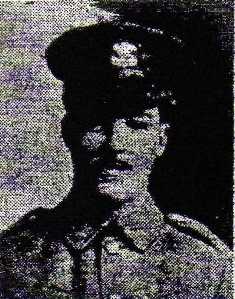
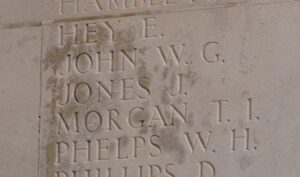
William Morris Jones, Private, 5562, Welsh Regiment. William, known as Morris, was the son of Thomas and Mary Jones, of Bridge Street, Llangennech. He resided at Penygroes prior to the war, and served with the 1/4th Battalion (Carmarthen), Welsh Regiment. The Battalion formed at the outbreak of war, and became attached to 159 Brigade, 53rd (Welsh) Division, landing at Gallipoli in August 1915. Here, the fresh troops were thrown into a series of suicidal assaults over the coming days, against strongly defended Turkish positions. Morris was killed here during the attack on Scimitar Hill on 10 August 1915. He was just 17 years old, and is commemorated on Panel 140-144 of the Helles Memorial, Gallipoli.
William Lynch, Corporal, 13014, Royal Welsh Fusiliers. William was born at Relton, Devon in 1868. He married Alice Ann Cox in 1894, and the couple moved to Troed y Rhiw House, Penygroes. William enlisted at Tumble into the 9th Battalion, Welsh Regiment, which was attached to 58 Brigade, 19th (Western) Division. In July 1915 the Division landed in France, and moved to positions north of Loos, near Neuve Chapelle. They took part in the Battle of Loos from 25 September onwards, and remained in the area during their first winter in France. The Division was still in the Loos Sector when William was killed in action on 7 February 1916, aged 48. He is buried in Merville Communal Cemetery, France.
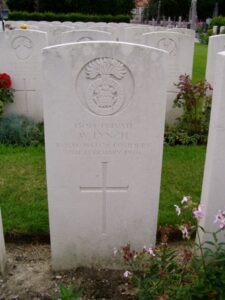
Harry Martin, Private, 242782, South Lancashire Regiment. Harry was the son of George and Mary Martin, of 15, Gorsddu Road, Penygroes. He enlisted in December 1914 into the 4th Welsh, before moving to France in August 1916, and being posted to the 7th Battalion, South Lancashire Regiment, which was attached to 56 Brigade, 19th (Western) Division. The Division crossed to France in July 1915, and moved to positions near Loos, where it took part in the opening attack of the Battle of Loos on 25 September 1915. The following year the Division moved to the Somme, where it took part in the second wave of the attack on Ovillers-La Boiselle on 1 July, capturing the village at heavy cost. It then fought through the Somme Battles of Pozières and the Ancre in 1916. In 1917 the Division moved North to Ypres, taking part in the Battle of Messines, and fought on the Menin Road and at Polygon Wood, before moving up to Broodseinde, Poelcappelle and Passchendaele Village itself. Harry was wounded at Ypres, and died of his wounds on 13 October 1917. He was 21 years old, and is buried in Outtersteene Communal Cemetery Extension, Bailleul, France.
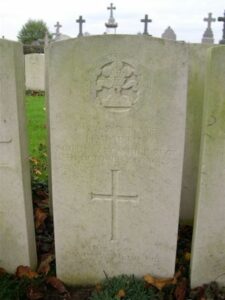
John McFarlane, Lance Corporal, 21107, Welsh Regiment. John was the son of John and Sarah Ann McFarlane, of Pontypridd, He married Myfanwy Llewellyn in 1906 and the couple moved to 2, Plasgwyn Terrace, Penygroes. He enlisted at Ammanford into the 16th Battalion, Welsh Regiment, which was the Cardiff City Battalion, attached to 115 Brigade, 38th (Welsh) Division. The Division moved to France in December 1915, and spent several months in the Fleurbaix sector, before moving to the Somme in June 1916, and taking part in the capture of Mametz Wood. The battered division moved via Hebuterne to positions at Boesinghe, north of Ypres, and remained there over the coming months, in preparation for the coming Third Battle of Ypres. The Division took part in the capture of Pilckem Ridge, before being pulled from the line to rest, leaving the 15th and 16th Welsh behind in support of the 20th Divisions attack on Langemarck. John was wounded here, and evacuated to Hospital at Wimereux, where he died on 2 October 1917. He was 36 years old, and is buried in Wimereux Communal Cemetery, France.
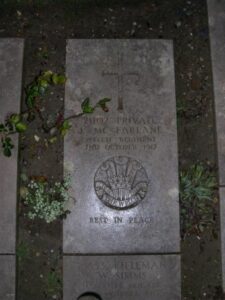
Thomas Griffiths Morgan, Private, 22134, Welsh Regiment. Thomas was the son of Richard and Mary Ann Morgans, of 2, Florence Road, Tir-y-dail, Ammanford. He lived at Penygroes prior to the war, and enlisted at Neath into the Welsh Regiment, and was posted to France to join their 2nd Battalion, which was attached to 3 Brigade, 1st Division. Thomas probably joined the battalion at Loos, where they fought during the Battle of Loos, and the action at the Hohenzollern redoubt. The Division later moved south to the Somme, where they fought during the opening of the Somme Offensive at the Battle of Albert, then at Bazentin, Pozières, Flers-Courcelette and Morval. Thomas was killed at Morval on 25 September 1916. He was 23 years old, and is commemorated on the Thiepval Memorial, France.
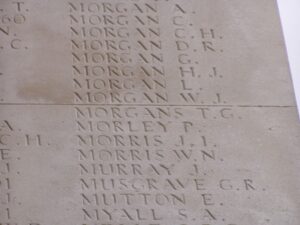
William Owen, Lance Corporal, Welsh Regiment. William cannot presently be identified.
Daniel Rees, Private, 12581, Devonshire Regiment. Daniel was the son of John and Sarah Rees, of 3, Lewis Street, Pontwelly, Llandyssul. He had lived at Penygroes prior to the war and enlisted at Ferndale into the 9th Battalion, Devonshire Regiment. The battalion was attached to 20 Brigade, 7th Division, and moved to Belgium on 6 October 1914, landing at Zeebrugge. Due to the imminent collapse of the Zeebrugge defences, the Division were moved south, and took up positions east of Ypres. Here, they fought the advancing German Army to a standstill during First Ypres, and settled down for their first winter on the Western Front. In March, 1915 they fought at the Battle of Neuve Chappelle, and then in May fought at Aubers Ridge. They then fought at Givenchy, before taking part in the Battle of Loos in September. After a hard winter near Loos, they moved to the Somme in June, 1916, and fought during the Somme Offensive, at the Battles of Albert and Bazentin. They then moved towards Delville Wood, where Daniel was killed in action on 4 September 1916. He was 22 years old, and is buried in Delville Wood Cemetery, Longueval, France.
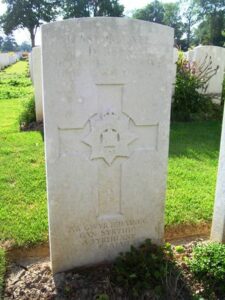
John David Rees, Private, 13188, Royal Welsh Fusiliers. John, known as David, was the son of John and Elizabeth Rees, later of Caehelyg, Penygroes. He enlisted at Ammanford into the 10th Battalion, Royal Welsh Fusiliers, who were attached to 76 Brigade, 3rd Division. The 10th RWF had landed at Boulogne on 27 September 1915 and saw their first action at Ypres, around the Bluff and St. Eloi area, and in October transferred to the 3rd Division with the Brigade. The Division fought during the Battle of the Somme in July 1916, and David was Killed in Action during the 10th RWF’s double Victoria Cross winning assault during the Battle of Delville Wood on 20 July 1916 aged just 20. He is remembered on the Thiepval Memorial, France.
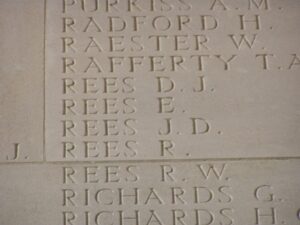
Emrys Roberts, Sergeant, 14342, Royal Welsh Fusiliers. Emrys was the son of John and Catherine Roberts, of Tyuchaf, Penygroes. He served with the 11th Battalion, Royal Welsh Fusiliers, who were attached to 67 Brigade, 22nd Division. The Division crossed to France in September 1915, but in October 1915 the Division moved by train to Marseilles, and began to embark for Salonika. It completed concentration there in November, taking part in the Retreat from Serbia during December 1915. During August 1916 they fought at the battle of Horseshoe Hill, then in September 1916 at the battle of Machukovo. Between 24-25 April and 8-9 May 1917 the Division fought at the battle of Doiran, and then on 18 September 1918 at the Second Battle of Doiran. Emrys was killed here on 18 September 1918. He was 25 years old, and was buried in Doiran Military Cemetery, Greece. His brother Evan had been killed just over three weeks earlier.
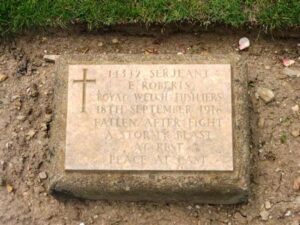
Evan John Roberts, Private, 688, Welsh Guards. Evan was the elder son of John and Catherine Roberts, of Tyuchaf, Penygroes. He was one of the first to enlist into the newly formed Welsh Guards in February 1915, joining the 1st Battalion, Welsh Guards, which moved to France in August 1915 attached to 3rd Guards Brigade, Guards Division. The Division saw its first major action during the Battle of Loos on 25 September 1915. In July 1916 the Division moved to the Somme, where they fought at the Battle of Flers-Courcelette, and the Battle of Morval, capturing Lesboeufs Village. They remained here for the winter, and in March 1917 took part in the advance caused by the German Retreat to the Hindenburg Line. Later that year they moved north to Ypres, where they fought at the Battle of the Pilkem, and at the Battle of the Menin Road, Battle of Poelcapelle and the First Battle of Passchendaele. November saw them move south again, where they took part in the Battle of Cambrai. They remained in the area over the final winter of the war, and were stationed near Gouzeaucourt when the German Spring Offensive hit the area on 21 March, 1918, at the Battle of St Quentin. The British retreated in the face of this onslaught, fighting at the First Battle of Bapaume, before the Guards Division retreated west and faced the Germans at the First Battle of Arras, 1918. After this, the German Offensive petered out on the Somme, and on 8 August the Australian Corps advanced towards the town of Villers Brettoneux and won a mighty battle there against the Germans, thus turning the war. On 21 August the British launched an attack on the Somme, and the Guards Division fought here at the Battle of Albert, and then pushed east, fighting at the Battle of Bapaume. Evan was killed during this great offensive on 24 August 1918. He was 38 years old, and is buried in Mory Abbey Military Cemetery, Mory, France. His brother Emrys was killed just over three weeks later.
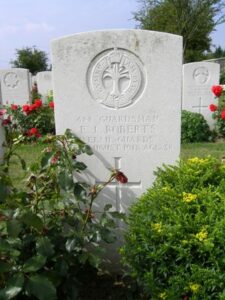
John Scott, Sergeant, 3055, Welsh Regiment. John was the son of John Scott and Mary Ann Scott, of 37, Victoria Street, Llandovery. He married Edith Atkins and the couple lived at 59, Gorsddu Road, Penygroes. He enlisted at Llandeilo into the 1/4th Battalion, Welsh Regiment, which was attached to 159 Brigade, 53rd (Welsh) Division, and sailed in July 1915 for the Mediterranean. On 9 August the Division landed at Suvla Bay, Gallipoli, and were plunged into a chaotic action. John was killed in action just two days later, on 11 August 1915, aged 29, during the Battle of Sari Bair. He is remembered on the Helles Memorial, Gallipoli. His father and a brother also fell, and all three are commemorated at Burry Port and Llandeilo.
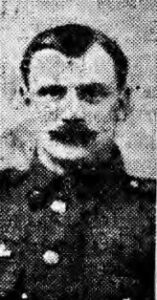
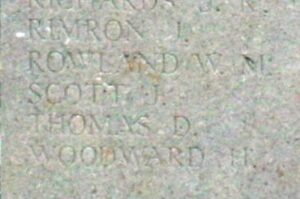
Charles Taylor, Sergeant, 88602, Royal Welsh Fusiliers. Charles was the son of George and Rachel Taylor, of Green Castle, Penygroes. He had enlisted into the Army, and in 1918 was posted to the 14th Battalion, Royal Welsh Fusiliers, which was attached to 113 Brigade, 38th (Welsh) Division in France. In April 1918 the Division were moved from Armentieres to the Somme Sector, to relieve battered elements of the British Army who had been pushed back over the old Somme battlefields during the German Spring Offensive of 21 March onwards. The Division was allotted the line north of Albert, towards Hamel, and 113 Brigade took over the Bouzincourt Sector. Over the coming months they fought many small scale actions, before taking part in the launching of the Battle of Albert on 21 August 1918, when the Division crossed the River Ancre, and began driving the Germans back towards the Hindenburg Line. Charles was wounded during the later Battle of the Selle. He died of his wounds aged 23 on 8 November 1918, and is buried in Dourlers Communal Cemetery Extension, France.
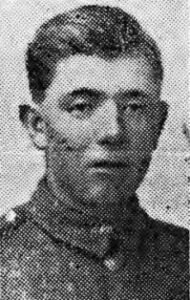
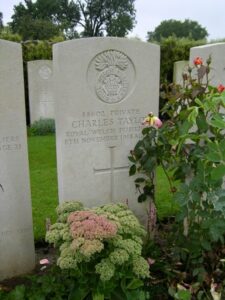
Thomas Thomas, Driver, 5673, Royal Field Artillery. Thomas was the son of Thomas and Catherine Thomas, of Brynarfon, Penygroes. He enlisted at Ammanford into the Welsh Royal Artillery, and joined A Battery, 121st Brigade, Royal Field Artillery, attached to 38th (Welsh) Division. The Division moved to France in December 1915, and took over the Fleurbaix Sector. It took part in the capture of Mametz Wood on the Somme the following year, and in 1917 captured the Pilckem Ridge, during the Third Battle of Ypres. In April 1918 the Division moved back to the Somme, but the Artillery stayed in the Lys Sector, and fought during the German offensive on the Lys that month, before rejoining the Division on the Somme. From 21 August 1918 onwards the Division crossed the flooded River Ancre, and began its drive towards the Hindenburg Line and beyond. Thomas was wounded during the Battle of the Selle. He was evacuated to Rouen for treatment, but died there on 8 November 1918. He was 21 years old, and is buried in St. Sever Cemetery Extension, Rouen, France.
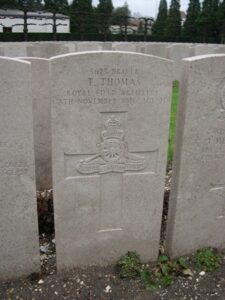
William John Thomas, Sapper, 166942, Royal Engineers. William was the son of Thomas and Mary Thomas, of Arwel, Penygroes. He enlisted at Cardiff on 7 December 1915 into the Royal Engineers. In November 1916 William was posted to France, joining the 207th Field Company, Royal Engineers, attached to 34th Division. The following year the Division took part in the First and Second Battles of the Scarpe, and the Battle of Arleux. In March 1918 the Division were in the St. Quentin sector, and were hit by the German Spring Offensive on 21 March. They fought here at the Battle of St Quentin, before being moved north to Flanders to rest. The Germans attacked in Flanders in April, and the Division were caught up in the Battle of Estaires, and fought a rearguard action westwards, fighting at the Battle of Messines, the Battle of Bailleul, and the First Battle of Kemmel. The Division suffered very severe casualties during its part in the defence of Kemmel, and was withdrawn and reorganised. In mid-May 1918 the Divisional infantry was reduced to a training cadre, and used for training American troops. Many reduced units were attached for short periods at this time. It was reconstituted as a full first-line Division late in June 1918, and moved back into the line, where it fought at the Battle of the Soissonnais and of the Ourcq, taking part in the Capture of Beugneux Ridge. William was killed here on 24 July 1918. He was 28 years old, and is buried in Raperie British Cemetery, Villemontoire, France. There is a memorial to him at Ammanford (Saron) Chapel.
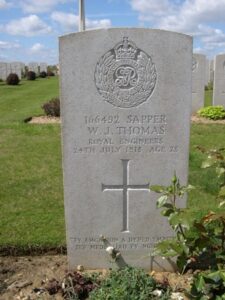
Henry Williams, Private, 11783, Royal Welsh Fusiliers. Henry was born at Penygroes, and enlisted at Cardiff into the 1st Battalion, Royal Welsh Fusiliers. The battalion was at Malta at the outbreak of war, returning to Britain to join 22 Brigade, 7th Division. The Division landed at Zeebrugge on 6 October 1914, but the City was falling, and the Division was moved to Ypres, where it became the first British Division to hold the city. They fought during the First Battle of Ypres, and helped stop the German advance through Belgium, and in March 1915 fought at the Battle of Neuve Chapelle. During May they fought at the Battle of Aubers Ridge, and at Festubert, before taking part in the Battle of Loos in September. In the summer of 1916, the Division were on the Somme, and took part in the Battle of Albert, where they captured Mametz, one of the few successes of 1 July 1916. They then fought at the Battle of Bazentin, and the Attacks on High Wood. Henry was killed here on 15 July 1916. He has no known grave, and is commemorated on the Thiepval Memorial, France. Henry is not named on the war memorial.

James Yockney, Private, 7229, Welsh Regiment. James was the son of James and Bridget Yockney, of 9, Dumfries Street, Aberdare. He resided at 58, Gorsddu Road, Penygroes prior to the war, and enlisted at Cardiff into the 2nd Battalion, Welsh Regiment. The battalion moved to France at the outbreak of war, attached to 3 Brigade, 1st Division, and took up positions near Mons. They then fought in the retreat from Mons to the Marne, before the Division was moved to positions at Gheluvelt, near Ypres. The 2nd Welsh made a famous stand at Gheluvelt, which helped stop the German drive towards the Channel. James was wounded during the later Battle of Nonne Boschen, and died of his wounds on 1 November 1914, aged 33. He is buried in Boulogne Eastern Cemetery, France. James is not named on the war memorial.
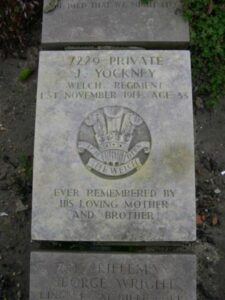
——————————————————————————————————————————————————————
World War Two, 1939-1945
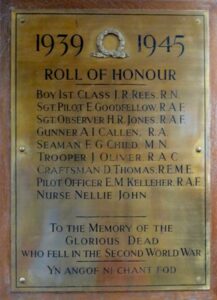
Arthur Idwal Callen, Gunner, 1152177, Royal Artillery. Arthur was the husband of Sarah Callen, of Belmont, Penygroes. He served with 2 Airlanding Anti Tank Battery, Royal Artillery, which was an elite unit attached to the 6th Airborne Division. The battery had been in France in 1940 attached to the 51st (Highland) Division, and was split in 1942, with 2 Airlanding Anti Tank Battery transferring to the Airborne. It saw action in North Africa and Italy before returning to England to train for the invasion of France as part of the 4th Parachute Brigade. On 18 September 1944 the battery landed by gliders in Arnhem, as part of the 6th Airborne, tasked with the capture and holding of the bridge over the Rhine. Arthur was killed in Arnhem on 26 September 1944, aged 29. He is buried in Arnhem Oosterbeek War Cemetery, Netherlands.
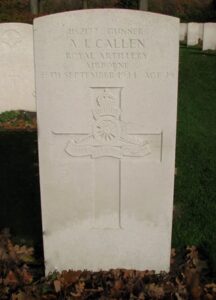
Francis George Child, Ordinary Seaman, Merchant Navy. Francis was the son of William John Child, and of Elizabeth Jane Child, of Penygroes. He served with the Merchant Navy aboard the MV British Vigilance, a London registered tanker. On 3 January 1943, British Vigilance was on route from Curacao via Trinidad to Gibraltar in Convoy TM-1, carrying a cargo of 11,000 tons of petroleum, when she was torpedoed by the German submarine U-514, about 900 miles from Barbados. The tanker was abandoned, and was sunk by another U-Boat two weeks later, but 27 men had been lost in the original attack. Francis was amongst the dead. He was 24 years old, and is commemorated on the Tower Hill Memorial, London.
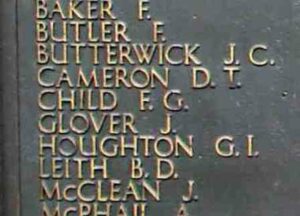
Emrys Goodfellow, Sergeant, 1176272, Royal Air Force Volunteer Reserve. Emrys was the son of John Goodfellow and Elizabeth Goodfellow (nee Griffiths), of Plain View, Penygroes. He served as an Observer with 37 Squadron, Royal Air Force, which was based at Gadarbia West, Malta, equipped with the Vickers Wellington III. On the night of 9 March 1943, Malta was suffering from German dive bombers. In the confusion, the Wellington, Serial DV 483, which Emrys was a crewman aboard, was taking off from the runway at Luqa when it collided with a Wellington bomber which was taxiing down the runway towards them. Both aircraft burst into flames, and rescue attempts were hampered by exploding bombs which were aboard both aircraft. Emrys was 28 years old when he died that night, and was buried in Malta (Capuccini) Naval Cemetery, Malta.
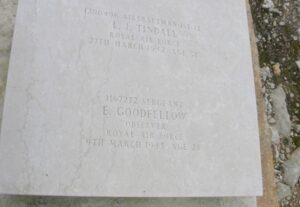
Nellie John, Nurse. Nellie cannot presently be identified.
Henry Raymond Jones, Sergeant, 1419935, Royal Air Force Volunteer Reserve. Henry was born on 4 April 1922, the son of Albert Sydney Jones and Hannah Jones (nee James), of Sunny Bank, Penygroes. His father had served with the 9th Royal Welsh Fusiliers during the Great War. Henry enlisted into the Royal Air Force Volunteer Reserve and after qualifying as a Bomb Aimer was posted to 78 Squadron, Royal Air Force, which was equipped with the Handley Page Halifax II, based at RAF Breighton. On the night of 24 August 1943, Henry took off from RAF Breighton aboard Halifax II, Serial JB874, which was bound for Berlin. The aircraft was in formation above Hull when it collided with another Halifax, and was sent crashing to the ground, killing all bar one of her crew. Henry was 21 years old when he died that night. His remains were conveyed home and he was buried in Penygroes Independent Chapelyard.
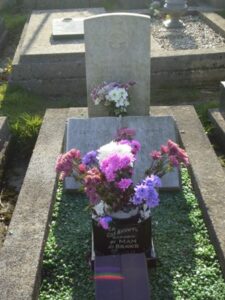
Francis Mostyn Kelleher, Pilot Officer, 162868, Royal Air Force Volunteer Reserve. Francis was the son of Michael Kelleher and Sarah Kelleher (nee Brewer), of Penygroes. He served as a Wireless Operator/ Air Gunner with 12 Squadron, Royal Air Force, which was a heavy bomber unit, based at RAF Wickenby, equipped with the Avro Lancaster III. On 27 January 1944 Francis was flying aboard Lancaster JB 283, which was en route for Germany. The aircraft had just crossed the coast when it was shot down by a German night fighter, and crashed with the loss of all seven men aboard. Francis was 21 years old when he died that day, and is buried in Rheinberg War Cemetery, Germany, alongside his fellow crewmen.

Saunders Eiragwyn Morgan, Flight Sergeant, 1578981, Royal Air Force Volunteer Reserve. Saunders was born at Arhosfa, Penygroes in 1919, the son of Evan Oswald Morgan and Sarah Morgan (nee Griffiths). His father was a coalminer who enlisted into the Birmingham City Police Force in 1920, moving the family to 33, Hampton Road, Birmingham. Saunders enlisted into the Royal Air Force Volunteer Reserve soon after the outbreak of war and trained as a Navigator, before being posted to 101 Squadron, Royal Air Force, which was based at RAF Ludford Magna, in Lincolnshire. During the early hours of 12 June 1944, Saunders took off from Ludford Magna aboard an Avro Lancaster I, Serial LL751, which joined a bomber force despatched to strike rail communications in France, in support of the Normandy Landings. Saunders was killed, together with all of his fellow crewmen, when their Lancaster crashed just northeast of the town of Evreux, near the target area, later that morning. The 24-year-old was buried besides his fellow crewmen in Evreux Communal Cemetery, France. Saunders does not appear to be commemorated locally.

John Oliver, Trooper, 14552314, Royal Armoured Corps. John was the son of Alcwyn Thomas Oliver, and of Lily Mary Oliver, of Penygroes. He served with the 107th Regiment, Royal Armoured Corps. The regiment was equipped with Churchill tanks, and landed on the Normandy beached in July 1944 attached to the 34th Tank Brigade. It took part in the break out from Normandy, and the subsequent drive through Belgium and Holland into Germany. John survived the war, but the regiment stayed in Germany after the surrender of Germany. John died in Germany on 26 September 1945, aged 20, and is buried in Munster Heath War Cemetery, Germany.
James Gilbert Rees, First Radio Officer, Merchant Navy. James was the son of Edwin Thomas Rees and Sarah Adelina Anne Rees, of Penygroes. He served with the Merchant Navy aboard the S.S. Harpalyce, a London registered cargo steamer. On 25 August 1940 she was off the Hebrides, returning from Halifax for Hull as part of Convoy HX-65A, carrying a cargo of 8000 tons of steel, when she was torpedoed and sunk by the German Submarine U-124, with the loss of 37 lives. James was 26 years old when he died that day, and is commemorated on the Tower Hill Memorial, London. James is not named on the war memorial.
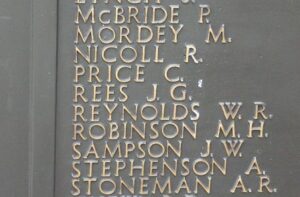
John Raymond Rees, Boy 1st Class, D/JX 164067, Royal Navy. John was the son of Thomas J. Rees and Mary Ann Rees (nee Jones), of Penygroes. He served aboard the battlecruiser H.M.S. Repulse. She took part in the Norwegian Campaign in 1940, and in the hunt for the Bismarck in 1941, before transferring to East Indies Command. Repulse was then assigned to Force Z, formed to counter the Japanese offensives in the Far East. On 10 December 1941, Repulse and H.M.S. Prince of Wales were attacked and sunk by Japanese dive bombers in the Indian Ocean, with heavy loss of life. John was just 17 years old when he died that day, and is commemorated on the Plymouth Naval Memorial, Devon.
Douglas Thomas, Craftsman, 10576464, Royal Electrical and Mechanical Engineers. Douglas was the son of Samuel and Annie Mary Thomas, of Penygroes. He served with the Royal Electrical and Mechanical Engineers. Little else is known of Douglas, but he was still in Germany after the war, and died there on 12 February 1946, aged 23. Douglas is buried in Munster Heath War Cemetery, Germany.